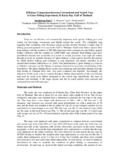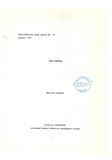Efficiency Comparison between Conventional and Vented Trap in Ghost Fishing Experiment, Si Racha Bay, Gulf of Thailand
記述
raps are an effective and economically important multi-species fishing gear used widely for harvesting crustaceans and finfish around the world. The collapsible trap targeting blue swimming crab (Portunus pelagicus) has recently becomes a major type of fishing gear and operated over year in the Gulf of Thailand. Small scale fishers operate their traps inshore with the numbers of 200-300 traps/boat while commercial scale fishers operate further (offshore) with the numbers of 2,000-5,000 traps onboard. Both fishing types have possibilities become lost or derelict as a result of several processes. Lost traps are widely thought to result in mortality because of “ghost fishing” a term used to describe the process by which derelict fishing gear continues to trap organisms and induce mortality in an uncontrolled manner (Matsuoka et al. 2005). The phenomenon of ghost fishing is a concern to fisheries managers and the fishing community interested in long term sustainability of the trap fishery. The ghost fishing effects on the blue swimming crab and other animals from the trap fishing in Thailand have been very poor evaluated and reported. Accordingly, the objectives of this study were to examine the ghost fishing characteristics of the conventional trap used by small scale fishers compared to the vented trap. Specifically, the rates of entrance and mortality of the target species and the by–catch species were assessed and compared between both trap types.
Citation
Putsa, S., Boutson, A., & Tunkijjanukit, S. (2015). Efficiency Comparison between Conventional and Vented Trap in Ghost Fishing Experiment, Si Racha Bay, Gulf of Thailand. SEAFDEC Technical Seminar 2015 (pp. 19-21). Samut Prakan: Training Department, Southeast Asian Fisheries Development Center
主題
Collections
Related items
Showing items related by title, author, creator and subject.
-
Standard Operating Procedures of Collapsible Fish Trap
Reungsivakul, Narong; Timkrub, Taweesak; Promjinda, Sayan; Yasook, Nakaret; Siriraksophon, Somboon (Training Department, Southeast Asian Fisheries Development Center, 2007)In early times, flowing water caused by tidal movement and changes in river and lake levels were probably used to trap fish behind rudimentary barriers, often made from sticks and stones. It is likely that early humans ... -
Coordination between Crab Trap and Crab Gill Nets Fisheries: Change and Adjustment of Fishing Gear for Responsible Fisheries Projects to Contribute Locally based Coastal Resource Management
Petchkamnerd, Jinda; Suanrattanachai, Phattareeya; Auimrod, Sayan (Training Department, Southeast Asian Fisheries Development Center, 2003)Crab fisheries in Tambol Pakklong composed of collapsible crab trap and crab gill net fishers. Collapsible crab trap fishers were classified into three sub-categories by size of wire. These were small sized wire, large ... -
Trap Fishing
Okawara, Masatake (Southeast Asian Fisheries Development Center, 1983-01)It is said that the demersal resources in coastal waters, particularly those in shallow waters and in flat sea-bottom areas, have already been over exploited. However, we can safely assume that there are many areas, even ...




